What does ESL mean in ELECTRONICS
Electronic System Level (ESL) describes the abstraction level of a system where system design is focused on the functional aspects of the components being modeled and their interactions. ESL modeling helps reduce design, development, and integration time because it allows designers to describe only essential characteristics of a component or system with little detail.

ESL meaning in Electronics in Academic & Science
ESL mostly used in an acronym Electronics in Category Academic & Science that means Electronic System Level
Shorthand: ESL,
Full Form: Electronic System Level
For more information of "Electronic System Level", see the section below.
Essential Questions and Answers on Electronic System Level in "SCIENCE»ELECTRONICS"
What is ESL?
Electronic System Level (ESL) describes the abstraction level of a system where system design is focused on the functional aspects of the components being modeled and their interactions.
How does ESL help in design?
ESL modeling helps reduce design, development, and integration time because it allows designers to describe only essential characteristics of a component or system with little detail.
How does ESL simplify things?
With ESL, engineers can focus more on creative designs and useful specifications instead of getting bogged down in hardware implementation details. This simplifies complex tasks by abstracting certain features for easier visualization and understanding.
What are the advantages of using ESL?
Using ESL has many advantageous features such as reduced complexity, faster design cycles, improved maintainability, improved predictability, and increased reusability among different applications.
Is there any downside to working with ESL?
One downside to working with ESL is that it requires more effort up front since designers have to think ahead about how they want their components to interact functionally before they can start coding them into specific hardware platforms.
Final Words:
Electronic System Level (ESL) provides engineers with an invaluable tool for quickly modelling complex systems without getting bogged down in all the details that go into actual hardware implementations. By providing a way for engineers to create simpler designs faster than ever before, it has revolutionized embedded systems engineering methodology over recent years.
ESL also stands for: |
|
| All stands for ESL |
